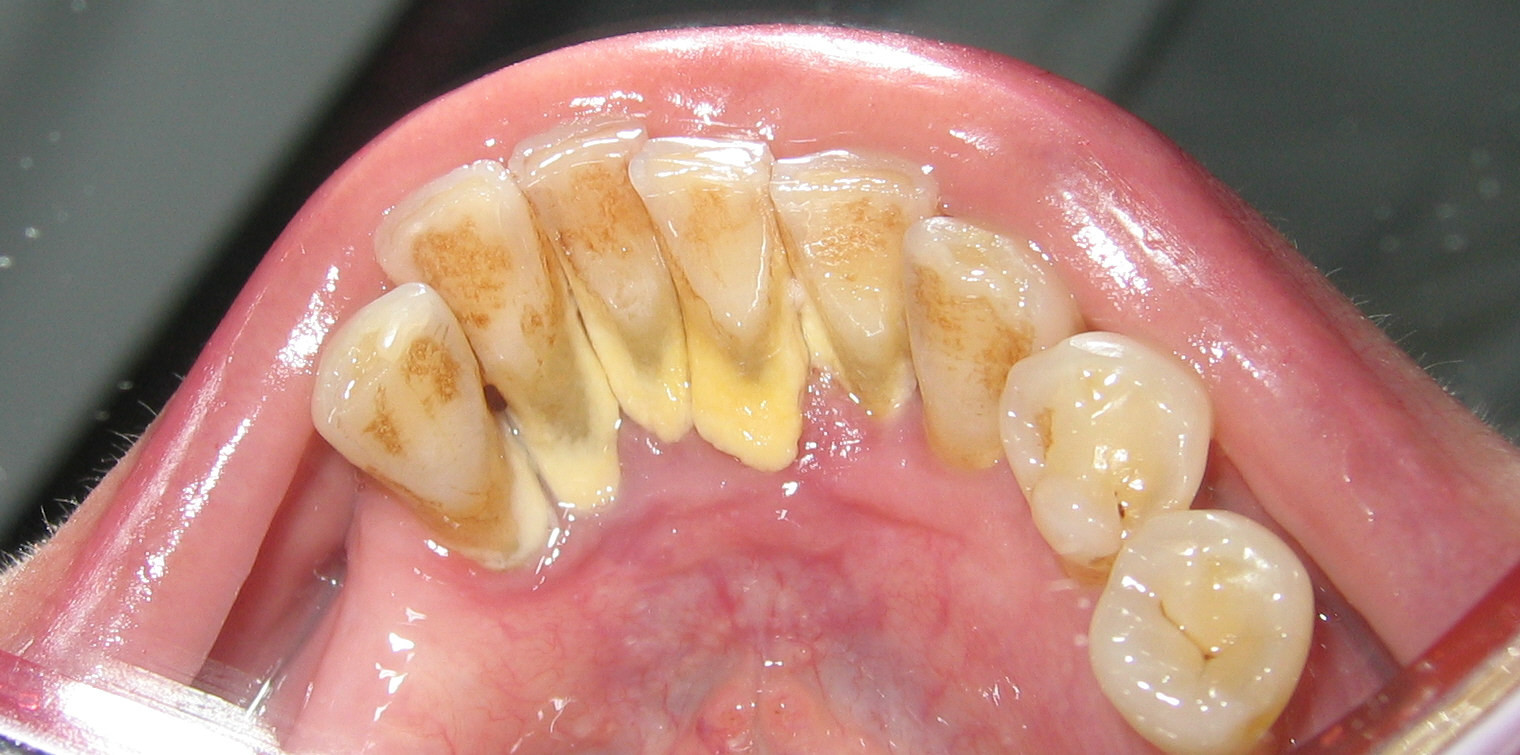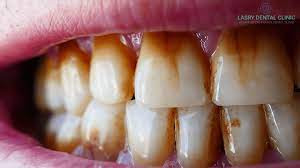Definition
Dental calculus is a form of dental plaque that permanently attaches and solidifies onto the outer layer of the teeth. Plaque is a thin film formed by the accumulation of germs, dirt, and food particles. The process of plaque calcification typically requires approximately 12 days.
The saliva's pH level is considered a significant factor in dental calculus. Calculus can rapidly accumulate in saliva with a pH above 7.
Calculus is difficult to eliminate with frequent cleaning or brushing. As a result, only a dentist can provide treatment. If left untreated, it may lead to several dental health problems.
Causes
Dental calculus primarily results from inadequate plaque removal. Plaque begins a calcification process over an extended period, resulting in the formation of calculus. Excessive accumulation of calculus on the teeth may negatively impact dental and oral health, including cavities and gingival disease, characterized by inflammation and irritation of the gingiva.
Several factors influence the rate of plaque formation in teeth, including:
- Density of teeth
- pH levels in saliva
- Oral bacteria
Risk factor
Several factors may increase the risk of dental calculus, including the following:
- Elderly
- Smoking
- Consuming sugary foods such as ice cream, candies, and cakes.
- Poor oral hygiene
- Drinking less water
- Brushing teeth less frequently
- Not using antibacterial mouthwash
- Taking medications that may impact dental health
- Dry mouth
- Consuming an excessive amount of carbohydrates
- Radiation therapy for head and neck cancer
Symptoms
Dental calculus commonly accumulates above or below the gingival line.
Dental calculus has a gritty texture when in contact with the tongue.
The accumulation of dental calculus results in various symptoms, including:
- Bleeding gums
- Halitosis is caused by decomposing food residue
- Irritation and inflammation leading to systemic diseases
- A yellow or brownish film of hardened debris at the gingival line
- Gingival swelling and redness.
- Gums are susceptible to bleeding during tooth scrubbing and flossing.
Diagnosis
The diagnosis of dental calculus requires a comprehensive dental examination. After interviewing the patient regarding their medical history and symptoms, the dentist will examine their mouth, teeth, and gingiva. The dentist will identify calculus on the teeth that require removal during the examination. Dental X-rays may confirm the condition of the teeth and gingiva if needed. This procedure may help detect the tooth damage.
Management
Dental calculus appears predominantly along the upper or lower gingival lines. It cannot be eliminated through simple tooth cleaning, so the dentist might suggest dental scaling to resolve this.
Scaling is a non-invasive medical procedure that does not require incisions and involves using a scaler, a specialized instrument that can scrape out dental calculus. Scalers may help to remove tartar manually or ultrasonically. Despite the disparity in scraping techniques, both instruments serve the same purpose. Ultrasonic scalers are more frequently used than manual scalers. The ultrasonic scaler expedites the scraping procedure and diminishes the pain.
Scaling treatment can be concurrently administered with routine dental health examinations scheduled at the dentist every six months.
Complications
The following complications may result from tartar accumulation:
- Dental caries
- Untreated gingivitis inevitably leads to periodontitis, an inflammatory disease affecting bone-supporting teeth.
- Teeth may loosen and fall out.
- The tooth color may shift to yellow or brown.
- Calculus may induce halitosis when plaque combines with food particles, damaging the oral cavity.
Prevention
There are several things to prevent dental calculus, including:
- Brush your teeth regularly
Brush your teeth for two minutes twice daily. This is the optimal duration for removing plaque, grime, and food particles from the tooth surface.
Use a compact, soft toothbrush capable of penetrating the space between the teeth. Ensure that each part of the teeth is reachable throughout the brushing process. Therefore, figure out the proper technique for brushing your teeth.
Avoid brushing your teeth straight after a meal. Saliva and food combine to create an acidic environment in the mouth and teeth, which might result in a small erosion of the enamel, the protective coating covering the teeth.
- Find the best toothpaste.
Some toothpaste products are commercially available. However, the selection of toothpaste should not be done without careful consideration. Ensure that the toothpaste contains fluoride. Fluoride, which is found in toothpaste, is beneficial in that it helps preserve teeth from damage.
- Floss your teeth
Because the spaces between teeth aren't always easy to clean, removing food particles stuck between them with a toothbrush might be challenging, allowing them to remain trapped. Dental floss may help reach these food residues.
- Use mouthwash
Rinse your mouth with oral mouthwash. Mouthwash can be used as a preventive treatment to inhibit the formation of dental calculus. Use an antiseptic mouthwash to eradicate oral bacteria.
- Maintain a healthy diet
The current diet may contribute to dental calculus. An increased consumption of saccharine or high-carbohydrate foods will result in the proliferation of bacteria and other microorganisms within the oral cavity. Sugar promotes bacterial proliferation in the oral cavity. Limiting the intake of sweet foods and beverages or cleaning one's palate immediately after consumption is advisable.
- Stop smoking
Tobacco compounds can potentially accelerate the accumulation of tartar on dental surfaces.
- See your dentist regularly
Visit your dentist at least once every six months to evaluate your oral health and prevent dental calculus and other problems
When to see a doctor?
This disorder can lead to more significant health issues, beginning with other dental conditions.
Therefore, seek your dentist right away if you have several uncommon symptoms.
Each body reacts differently. Even without symptoms, visit a dentist to discuss your dental health and get frequent checkups. The dentist will prescribe the appropriate treatment based on your condition.
Looking for more information about other diseases? Click here!
- dr. Lukita Tarigan
Fons-Badal, C., Fons-Font, A., Labaig-Rueda, C., Fernanda Solá-Ruiz, M., Selva-Otaolaurruchi, E., & Agustín-Panadero, R.(2020). Analysis of predisposing factors for Rapid Dental Calculus Formation. Journal of Clinical Medicine, 9(3), 858. https://www.mdpi.com/2077-0383/9/3/858
Clevend Clinic (2020). Disease & Conditions. Dental Plaque. Retrieved 20 januari 2023, from https://my.clevelandclinic.org/health/diseases/10953-plaque
Elias-Boneta, A., et al. (2018). Prevalence of Gingivitis and Calculus in 12-Year-Old Puerto Ricans: A Cross-Sectional Study. BMC Oral Health. Retrieved 20 januari 2023, from https://pubmed.ncbi.nlm.nih.gov/29351752/
Scaling and root planing for gum disease. MouthHealthy. (n.d.). Retrieved February 1, 2023, from https://www.mouthhealthy.org/all-topics-a-z/scaling-and-root-planing











